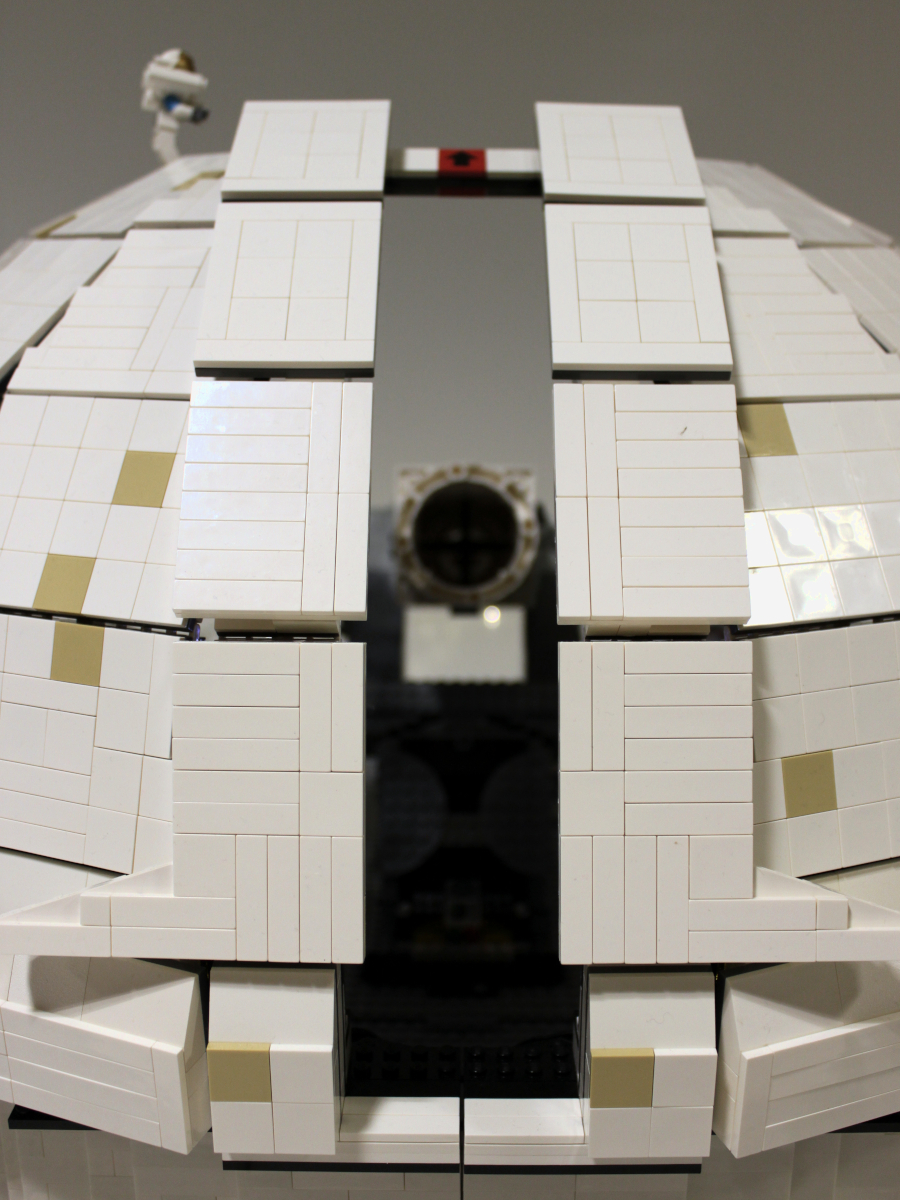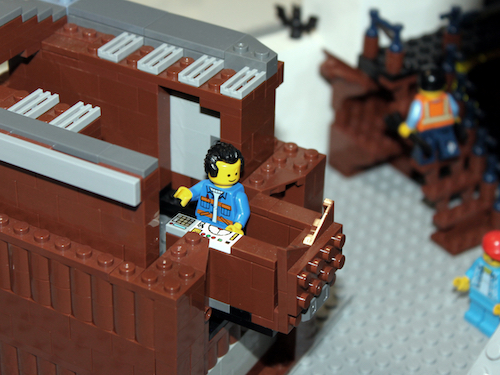Young visitors enthusiastically surrounded the world's largest plug-in building block model of the Alfred Jensch Telescope during the Long Night of Stars 2024 . On that day, it was presented to the public for the first time. The model offers the opportunity to explain to children (and their parents) how the optical telescope works. The Tautenburg Tiny Telescope in the opened model dome. Foto: TLS
The Tautenburg Tiny Telescope in the opened model dome. Foto: TLS
Dr. Thomas Sperling und Dr. Christian Andreas, both researchers at the Thuringian State Observatory, completed the brick model in their spare time in around six months with a great deal of dedication. They built a true-to-scale replica of the Alfred Jensch telescope, half of the dome roof and the observation platform which was used for observations in the past. Sperling and Andreas gave the 50-centimetre-high model the name "Tautenburg Tiny Telescope".
It was important to the two scientists to integrate basic functions, such as the movement of the telescope around two axes. "This was ultimately a key requirement for our project. We hope that it will also get the younger generation interested in our work and in astronomy," Sperling said. Originally, the idea was to simply replicate the telescope. Gradually, however, further details - such as the wooden observation platform, part of the dome structure and the TES telescope ("Tautenburg Exoplanet Search Telescope”) were added.
A total of around 4,000 individual parts installed
There was no building plan. "We initially based it on the size of classic LEGO® figures, which also explains the 1:45 scale. We then expanded the model piece by piece using old construction plans and floor plans," Andreas described the process. In total, around 4,000 individual parts were gradually added.
Movable in two directions
Mounting the telescope was a particular challenge. In order for an optical telescope to observe a celestial object - such as a star - throughout the night, two axes of movement are required: from north to south and from east to west in relation to the celestial poles and the celestial equator. "You can think of it like longitude and latitude lines in the night sky", Sperling explained.
For smooth tracking in the sky, the telescope's center of gravity must also be as close to these axes as possible . "You can compare it to a seesaw", Andreas added: "If you want to bob up and down really quickly, the children have to find exactly the right distance from each other so that the weights on both sides compensate for each other".
The Alfred Jensch telescope was designed in such a way that the weight of the telescope tube is balanced along one axis by the mirror, which weighs more than two tons. In the model, around 800 grams of lead plates had to be hidden behind the plastic mirror for this purpose.
Trial and Error - just like in research
The two astronomers had to work hard, but were rewarded with an "extragalactic fun factor", Sperling said. He added: "Of course, we benefited from the fact that we have been enthusiastic about LEGO® since we were children. And the approach was not so different from our scientific work. Even in basic research, it often starts with just an idea. The path to results is then more a matter of trial and error, sometimes accompanied by setbacks, similar to the search for the exit from a labyrinth".
The positive response from the public, young and old, during the Long Night of the Stars shows that the effort was worth it. The two builders permanently handed over the model to the observatory on November 5, 2024, in the presence of the institute's director, Prof. Dr. Markus Roth. It can now also be viewed as part of guided tours of the institute. If you look closely, you may discover other nocturnal superheroes in the model alongside busy astronomers.
Free guided tours of the institute for individuals take place on the first Thursday of each month at 4 pm at the Thuringian State Observatory and last around 45 minutes. Registration is not required.
Author: Christian Andreas
Note: LEGO® is a trademark of the LEGO Group. This website is not sponsored, authorized or endorsed by the LEGO Group.
 A detail in the model of the Alfred Jensch Telescope. Foto: TLS A detail in the model of the Alfred Jensch Telescope. Foto: TLS |
 The observation desk, located in the dome, as a model. Foto: TLS The observation desk, located in the dome, as a model. Foto: TLS |

